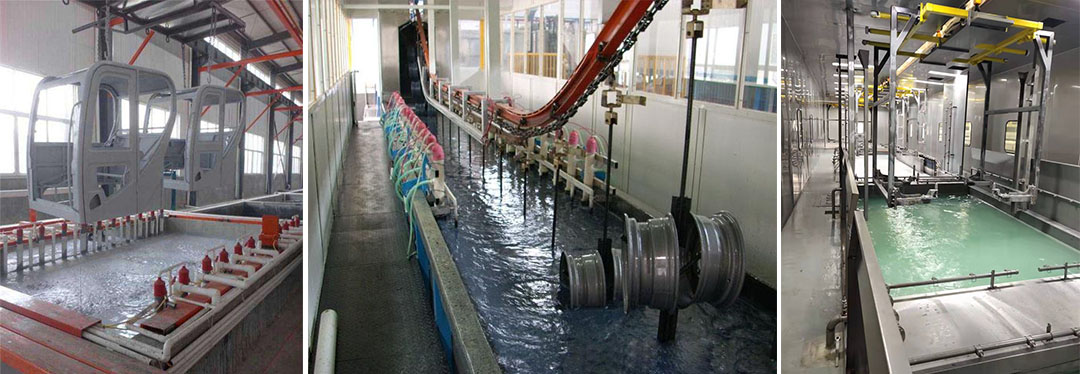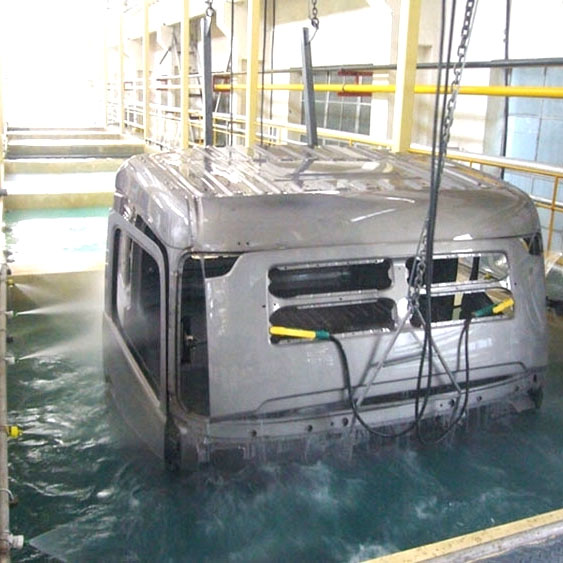Automobile cab electrophoresis production line
Electrophoretic painting generally involves four simultaneous processes
1. Electrophoresis: under the action of direct current electric field, positive and negative charged colloidal particles to negative, positive direction movement, also known as swimming.
2. Electrolysis: the oxidation reduction reaction is carried out on the electrode, but the oxidation and reduction phenomenon is formed on the electrode.
3. Electrodeposition: due to electrophoresis, the charged colloidal particles moved to the anode near the template surface body released electrons, and insoluble deposition, precipitation phenomenon, at this time the paint film formed.

4. Electroosmosis: under the action of an electric field, the solid phase does not move, but the liquid phase moves phenomenon. Electroosmosis causes the water content in the paint film to be gradually discharged to the outside of the film, and finally forms a dense paint film with very low water content and high resistance, which can hardly pass through the current.
5. Red iron oxide epoxy electrophoretic paint, for example: the electrophoretic paint is a modified epoxy resin, butanol and ethanol amine, talcum powder, red iron oxide material composition, electrophoresis paint mixes with distilled water, under the effect of dc field, that is separated into positively charged cationic and anionic, negatively charged and a series of complex colloidal chemistry, physical chemistry electrochemical process.
Electrophoretic coating methods and skills
1. Electrophoretic coating of general metal surface, its process is: pre-cleaning → on-line → degreasing → washing → rust removal → washing → neutralization → washing → phosphating → washing → passivation → electrophoretic coating → in-tank cleaning → ultra-filtration washing → drying → offline.
2. The substrate and pretreatment of the coating have a great influence on the electrophoretic coating film. Castings generally use sandblasting or shot blasting for rust removal, with cotton yarn to remove floating dust on the surface of the workpiece, with 80# ~ 120# sand paper to remove residual steel shot and other sundries on the surface. The surface of steel is treated with oil removal and rust removal. When the surface requirements are too high, phosphating and passivation surface treatment can be carried out. Ferrous metal workpiece must be phosphating before anodic electrophoresis, otherwise the corrosion resistance of the paint film is poor. Phosphating treatment, generally choose zinc salt phosphating film, thickness of about 1 ~ 2μm, requires fine and uniform crystallization of phosphating film.
3. In the filtration system, the general use of a filter, filter for mesh bag structure, aperture of 25 ~ 75μm. Electrophoretic paint is filtered through a vertical pump to a filter. Considering the factors such as replacement period and film quality, the filter bag with aperture 50μm is the best. It can not only meet the quality requirements of film, but also solve the blockage problem of filter bag.
4. The circulation quantity of electrophoretic coating system directly affects the stability of bath liquid and the quality of paint film. With the increase of circulation, the precipitation and bubble in the tank decrease. However, the aging of the tank is accelerated, the energy consumption increases, and the stability of the tank becomes worse. It is ideal to control the circulation number of tank liquid 6 ~ 8 times /h, not only to ensure the quality of paint film, but also to ensure the stable operation of tank liquid.
5. With the prolongation of production time, the impedance of the anode diaphragm will increase, and the effective working voltage will decrease. Therefore, according to the loss of voltage in production, the working voltage of the power supply should be gradually increased to compensate the voltage drop of the anode diaphragm.
6. Ultrafiltration system controls the concentration of impurity ions brought into the workpiece to ensure the coating quality. In the operation of this system, attention should be paid to the continuous operation of the system after operation, discontinuous operation is strictly prohibited to prevent the drying of the ultrafiltration membrane. The dried resin and pigment adhere to the ultrafiltration membrane and cannot be thoroughly cleaned, which will seriously affect the permeability and service life of the ultrafiltration membrane. The effluent rate of ultrafiltration membrane decreases with the running time, and it should be cleaned once for 30 to 40 days in order to ensure the ultrafiltration water required for leaching and washing.
7. Electrophoretic coating method is suitable for a large number of production lines. The replacement cycle of the electrophoresis tank should be less than 3 months. Taking an electrophoresis production line with an annual output of 300,000 steel rings as an example, it is very important to scientifically manage the tank liquid. Various parameters of the tank liquid are tested regularly, and the tank liquid is adjusted and replaced according to the test results. Generally, the parameters of the tank liquid are measured at the following frequency: PH value, solid content and conductivity of electrophoresis solution, ultrafiltration and ultrafiltration cleaning solution, cathode (anode) liquid, circulating washing solution and deionized cleaning solution once a day; Face base ratio, organic solvent content, laboratory small tank test twice a week.
8. The quality of the paint film management, should often check the uniformity and thickness of the film, the appearance should not have pinhole, flow, orange peel, wrinkles and other phenomena, regularly check the adhesion of the film, corrosion resistance and other physical and chemical indicators. Inspection cycle according to the manufacturer's inspection standards, generally each lot should be tested.
The application of electrophoretic coating and waterborne paint marks a great progress in coating industry.
Electrophoretic coating construction speed, mechanization and automation can be realized, continuous operation, reduce labor intensity, uniform paint film, strong adhesion, for the general coating method is not easy to be coated or badly coated parts, such as the above mentioned ribs, welds and other places can get even, smooth paint film. Paint utilization rate up to 90%-95%, because electrophoretic paint is water as a solvent, non - flammable, non - toxic, easy to operate and other advantages. Electrophoretic drying paint film, with excellent adhesion, its rust resistance, corrosion resistance, weather resistance and other properties are better than ordinary paint and general construction method.
Used for all kinds of workpiece painting, other models can be customized.




